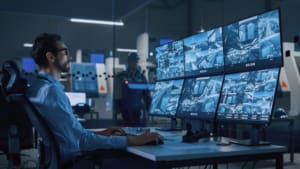Innovations in Access Control: Physical and Virtual
As the name suggests, access control technology aids in enabling or disabling access to a physical or virtual space, in an effort to increase security and deter individuals with malicious intent. As workplaces have shifted from primarily in-person office buildings to hybrid or even remote environments, and as cybercriminals have increased their sophistication, access control technologies and policies have had to adapt as well. How has access control improved recently?
Physical security
On-site access control provides a layer of security to occupants and data or equipment housed within a building by controlling who is allowed to enter and recording entry and exit activities through access logs. Unfortunately, this is not a foolproof system. If an access code or key is stolen, it can be used to access the facility, creating a security threat. By combining physical access control systems with security cameras, teams can better monitor activities on the premises.
For the team at My Brother’s Table, a nonprofit soup kitchen located in Lynn, Massachusetts, ensuring the safety and well-being of their employees, volunteers, and visiting families is a top priority. When they experienced degradation in their analog cameras and intercoms, these systems stopped functioning altogether — so they reached out to the team at K & M Communications for help. The team upgraded their network wiring to better support the new and existing devices. As shared by Mike Coffey, Operations Manager of K & M, “We replaced their old cameras with new Axis M-line HDTV megapixel cameras and added cameras to areas that weren’t covered before. To improve door security, we swapped out their old intercoms with new Axis network video intercoms and linked them to AXIS Camera Station Secure Entry which allows them to control their video and access control systems within a single platform. We also installed Axis keycard readers at designated doors for credentialed volunteers and service providers to use for entry into the facility.” As a result of the upgrade, the staff at My Brother’s Table saw an immediate impact in maintaining civility, safety, and security.
![]()
Integrating cameras into physical access control systems can provide the level of security needed to combat common risks. For example, with the use of both systems, teams can subvert attempts to access the building by disgruntled former employees or vendors, as well as potential tailgaters or unaccounted-for visitors. As the folks at My Brother’s Table also learned, the extra visibility provided by the integrated cameras aided in monitoring activity such as deliveries and parking issues.
Online security
Cybersecurity is a growing problem across all industries today. The cost of a cyberattack that results in a data breach can be tremendous, not only to a company’s finances, but also to its reputation and stability among customers. According to IBM, the average cost of a data breach in 2021 was a hefty $4.24 million.
As more businesses proceed with hybrid or remote workplaces, the threat of cyberattacks increases. To add an extra layer of security for virtual access control, many teams are implementing a zero-trust policy and multifactor authentication (MFA) protocols. A zero-trust policy treats incoming requests as if they originated from an untrusted source, requiring every interaction to be validated through an authentication process. In 2021, the White House released an executive order related to improvements to cybersecurity and their commitment to a zero-trust policy, stating, “The Federal Government must adopt security best practices; advance toward Zero Trust Architecture; accelerate movement to secure cloud services, including Software as a Service (SaaS), Infrastructure as a Service (IaaS), and Platform as a Service (PaaS); centralize and streamline access to cybersecurity data to drive analytics for identifying and managing cybersecurity risks; and invest in both technology and personnel to match these modernization goals.”
Multifactor authentication is an effective method to ensure online security by restricting access to only those individuals who are able to provide multiple forms of evidence to their identity. This may take the form of inputting a password followed by entering a code that the individual receives via text message to their smartphone.
 Integration
Integration
Access control and security systems should be integrated for optimal performance and visibility. The ability to access security information, including entry and exit data, software access, visual information from cameras, and more can provide an all-in-one protection plan for a possible breach, whether it be physical or virtual.
Additional security features that should be considered include:
- Lockdown systems. In the event of an emergency, access can be secured across all physical and virtual entry points.
- Unauthorized exit prevention. In locations like schools or hospitals, access control — either in or out — is a big deal. Whether it’s students trying to sneak out of class early or a confused elderly patient attempting to leave the hospital unsupervised, exit prevention is important.